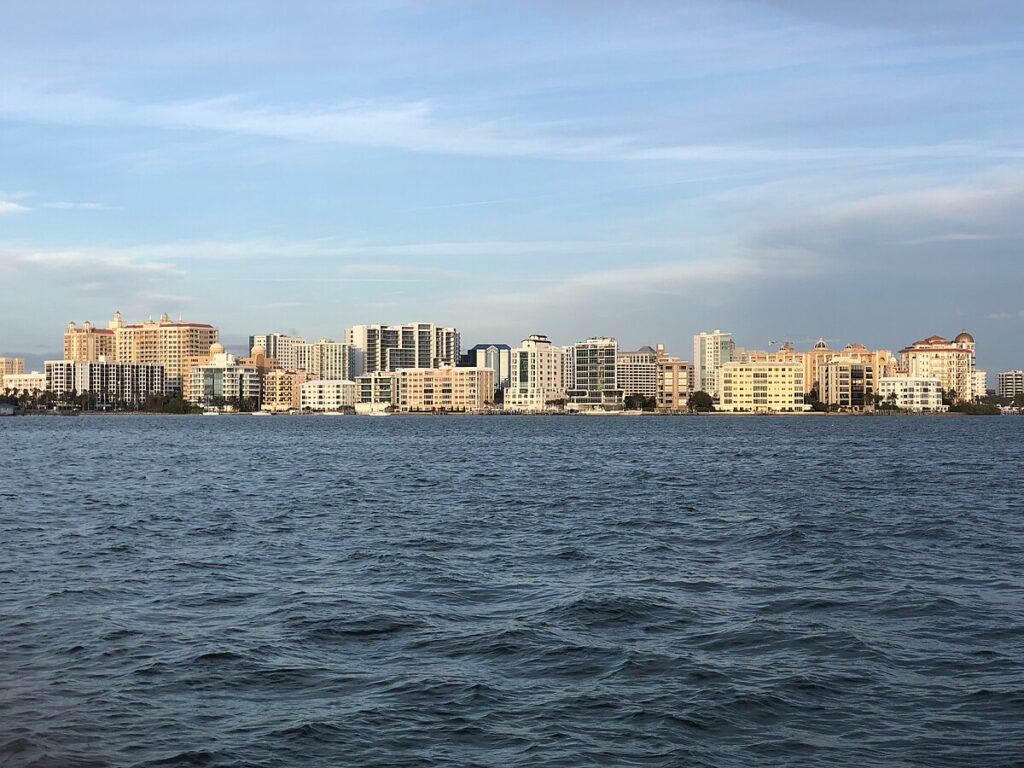
Moving to Sarasota, Florida: A Comprehensive Relocation Guide
Considering moving to Sarasota, Florida? This cultural Gulf Coast city offers pristine beaches, arts scene, and upscale lifestyle. With approximately 58,000 residents in 2025 (metro 840,000+), Sarasota combines coastal elegance with cultural sophistication and Southwest Florida’s premier arts destination.
Demographic Profile to Consider If Moving to Sarasota:
Sarasota’s 2025 city population is approximately 58,000 residents, with the metro area exceeding 840,000. The median age is around 53 years, reflecting strong appeal to affluent retirees and cultural enthusiasts. The population is approximately 78% White, 13% Hispanic, 5% Black or African American. Sarasota features upscale neighborhoods, historic districts, barrier island beaches including Siesta Key and Lido Key, and a vibrant downtown. The city’s identity centers on arts and culture with world-class venues and events. Sarasota attracts wealthy retirees, artists, cultural professionals, and affluent families seeking refined Gulf Coast lifestyle. The community emphasizes arts, culture, and quality of life. Find trusted local services for moving, living, and working in Sarasota.Sarasota Relocation Directory
Cost of Living to Consider If Moving to Sarasota:
Sarasota represents premium pricing for Southwest Florida. Median home values range from $450,000 to $700,000+ in 2025, with beachfront and downtown properties commanding significantly more. The median household income is approximately $70,000, though wealth concentration is substantial. Rental properties average $2,200 to $3,500+ monthly. Florida’s lack of state income tax attracts wealthy residents. Overall cost of living reflects Sarasota’s cultural amenities, beaches, and upscale character. The city attracts affluent retirees, professionals, and cultural enthusiasts. Housing costs create relative exclusivity while maintaining diverse neighborhoods. The combination of culture, beaches, and quality of life justifies premium pricing. Sarasota ranks among Florida’s most expensive cities.
Economy and Job Market:
Sarasota’s economy includes healthcare, tourism, arts, professional services, and real estate. Major employers include Sarasota Memorial Hospital, PGT Innovations, Sarasota County Schools, Roper Technologies, and numerous arts organizations. The cultural sector employs thousands through theaters, museums, and festivals. Tourism supports extensive hospitality employment. Real estate and construction serve the luxury market. Many residents are retirees or work in healthcare, professional services, and arts. The broader Sarasota-Bradenton metro offers diverse opportunities. Typical industries include healthcare, arts, hospitality, and professional services. The affluent population supports upscale retail and restaurants.
Education:
Sarasota County Schools serves city students with schools including Sarasota High School, Riverview High School, and various top-performing elementary and middle schools. The district offers magnet programs and choice schools. Private schools including Out-of-Door Academy and Cardinal Mooney serve families. State College of Florida campuses provide associate degrees. New College of Florida and Ringling College of Art and Design offer specialized four-year programs. The University of South Florida Sarasota-Manatee provides additional options. The educational infrastructure serves the community well with emphasis on arts education.
Recreation and Lifestyle:
Sarasota offers world-class cultural amenities including The Ringling museum complex with art museum, circus museum, and Ca’ d’Zan mansion. The Sarasota Opera, Asolo Repertory Theatre, and Sarasota Orchestra present performances. Downtown’s vibrant Main Street features galleries, restaurants, and shops. Spectacular beaches include Siesta Key Beach (consistently ranked America’s best beach), Lido Key, and Longboat Key. Marie Selby Botanical Gardens showcases tropical plants. The Mote Marine Laboratory & Aquarium provides marine science education. St. Armands Circle offers upscale shopping and dining. Annual events include the Sarasota Film Festival. Residents enjoy boating, fishing, cultural events, and beach activities. The lifestyle emphasizes arts, culture, beach enjoyment, and refined leisure. The subtropical climate enables year-round cultural and outdoor activities. The community values arts, education, environmental stewardship, and sophistication.
Healthcare and Services:
Sarasota residents access world-class healthcare through Sarasota Memorial Hospital (consistently ranked among America’s best), multiple specialty hospitals, and comprehensive medical services. The region’s healthcare infrastructure is excellent, serving the affluent aging population with specialized care in all disciplines. The concentration of medical facilities ensures quality healthcare access.
Transportation:
Sarasota benefits from Interstate 75, U.S. Highway 41 (Tamiami Trail), and various corridors. Sarasota-Bradenton International Airport provides extensive domestic flights. Sarasota County Area Transit (SCAT) operates bus routes. Downtown and some areas offer walkability. Most residents use personal vehicles. Typical commute times within the metro are reasonable. Traffic increases during tourist season.
Conclusion:
Moving to Sarasota in 2025 offers cultural coastal living with world-class arts, spectacular beaches, and sophisticated lifestyle. The city’s combination of Ringling museums, Siesta Key beaches, vibrant downtown, and cultural richness makes it ideal for affluent retirees, arts enthusiasts, and cultured professionals seeking Southwest Florida’s premier destination where beaches meet Broadway and sophistication defines daily life.

